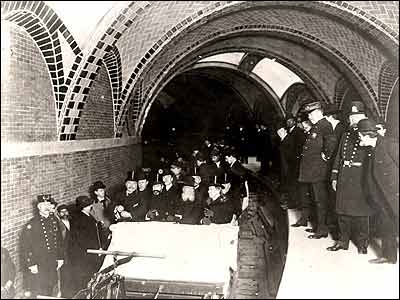
Penthouse Secrets
In 1903, producer Daniel Frohman opened the Lyceum Theatre on West 45th Street as “the home of drawing-room comedy.” Above the theater he built his own personal drawing room overflowing with Victoriana. One room had a small trap door through which Frohman could watch the stage. Legend has it that during productions featuring his wife, Margaret Illington, he would wave a white flag to signal that she was over-acting. Today, the penthouse serves as the offices of the Shubert Archive.
Just one block south, Frohman’s extravagant contemporary David Belasco built his own theater in 1907—a marvel of plaster, mahogany, and Tiffany glass. Later he added a ten-room duplex penthouse, in which he reputedly entertained lady friends. Now it’s closed and empty—which might account for the stories of a showgirl’s ghost in the elevator shaft.
In 1926, on the roof of an office building at 23rd Street and Park Avenue South, millionaire contractor Bill Kenny—childhood friend and major backer of Governor Al Smith—built the Tiger Room, a private clubhouse retreat. Named for the “Tammany Tigers,” the lavish penthouse featured a huge fireplace, tiger skins, brass tigers, and tiger paintings. Entertainment was provided by Al Jolson, Will Rogers, and, on one occasion, the entire cast of The Ziegfeld Follies. But politics dominated. “You couldn’t no more get up to that Tiger Room than you could get into heaven, unless you were a damn good contributor,” producer Eddie Dowling once said. The Tiger Room—minus all tigers—is now rented out as offices.
Basement Legends
The Vermeers are lovely. But the basement of the Frick—built in 1913 as the lavish home of Henry Clay Frick—still houses the steel magnate’s original billiards table and his two-lane pine-and-maple bowling alley (all redolent of leisurely brandy evenings). The lanes are restored but off-limits, used only for occasional museum functions.
Built on Park Avenue in 1931, the Waldorf-Astoria sits high above the old New York Central Railroad. And once upon a time, there was a special siding under the hotel for guests’ private rail cars. The Vanderbilts, for instance, could pull up and be met by a bellman who would trundle their luggage to the family suite. These days, Metro-North parks its service cars on the siding.
A Church’s Secret
St. Augustine’s at 290 Henry Street opened in 1828 as All Saints’ Free Church—“free” meaning no fee charged for the pews. But freedom did not extend throughout the church, whose construction coincided with the waning years of legal slavery here. Narrow staircases lead up to two “slave galleries,” half-hidden rooms through which the parishioners’ slaves could see and hear the services without themselves being seen. St. Augustine’s has restored the galleries and is documenting their history.

Lost to the Public
At 70 Pine Street, the old Cities Service Building rises 66 stories into the sky. An Art Deco extravaganza that opened in the middle of the Depression, it includes a glass-enclosed solarium, where a specially designed elevator discharges its passengers and then disappears back under the floor, leaving visitors in a crystalline dome with spectacular views. Cities Service founder Henry L. Doherty originally considered making the solarium his own “rest and recreation” zone, but he relented, opening it instead as a public observatory—“admission 40 cents.” Now it’s part of the AIG building. Sadly, the public is no longer invited.
Deep beneath City Hall Park, one of the grander subway stops has sat vacant and unused since its closing in 1945. (Only the nearby Brooklyn Bridge station could accommodate the new ten-car trains.) Built as the dramatic entrance to the IRT line, the City Hall station is a handsome curving space with brick and terra-cotta tile walls and a ceiling of Guastavino vaults. Today, the downtown No. 6 loops through the station on its way back uptown—but, alas, no passengers are allowed.